Analysis of Leadership Behaviours
VerifiedAdded on 2023/04/06
|14
|3552
|420
AI Summary
This essay analyzes two behavioral leadership theories - production oriented leadership behavior and employee oriented leadership behavior. It discusses the characteristics, pros, and cons of each style and how they are suitable for different situations. The essay also examines the management development program of John Lewis & Partners, a successful employee-owned organization.
Contribute Materials
Your contribution can guide someone’s learning journey. Share your
documents today.
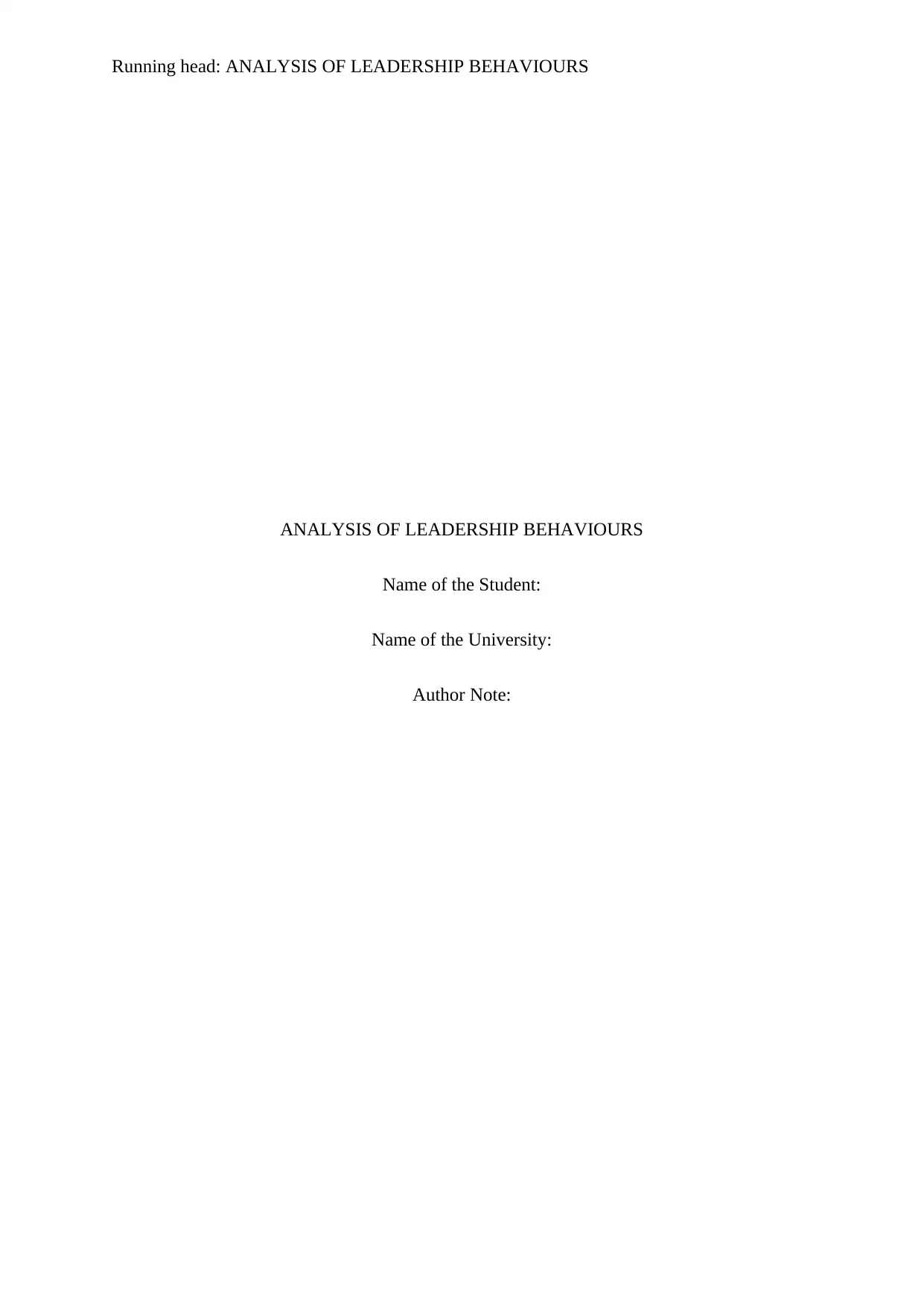
Running head: ANALYSIS OF LEADERSHIP BEHAVIOURS
ANALYSIS OF LEADERSHIP BEHAVIOURS
Name of the Student:
Name of the University:
Author Note:
ANALYSIS OF LEADERSHIP BEHAVIOURS
Name of the Student:
Name of the University:
Author Note:
Secure Best Marks with AI Grader
Need help grading? Try our AI Grader for instant feedback on your assignments.
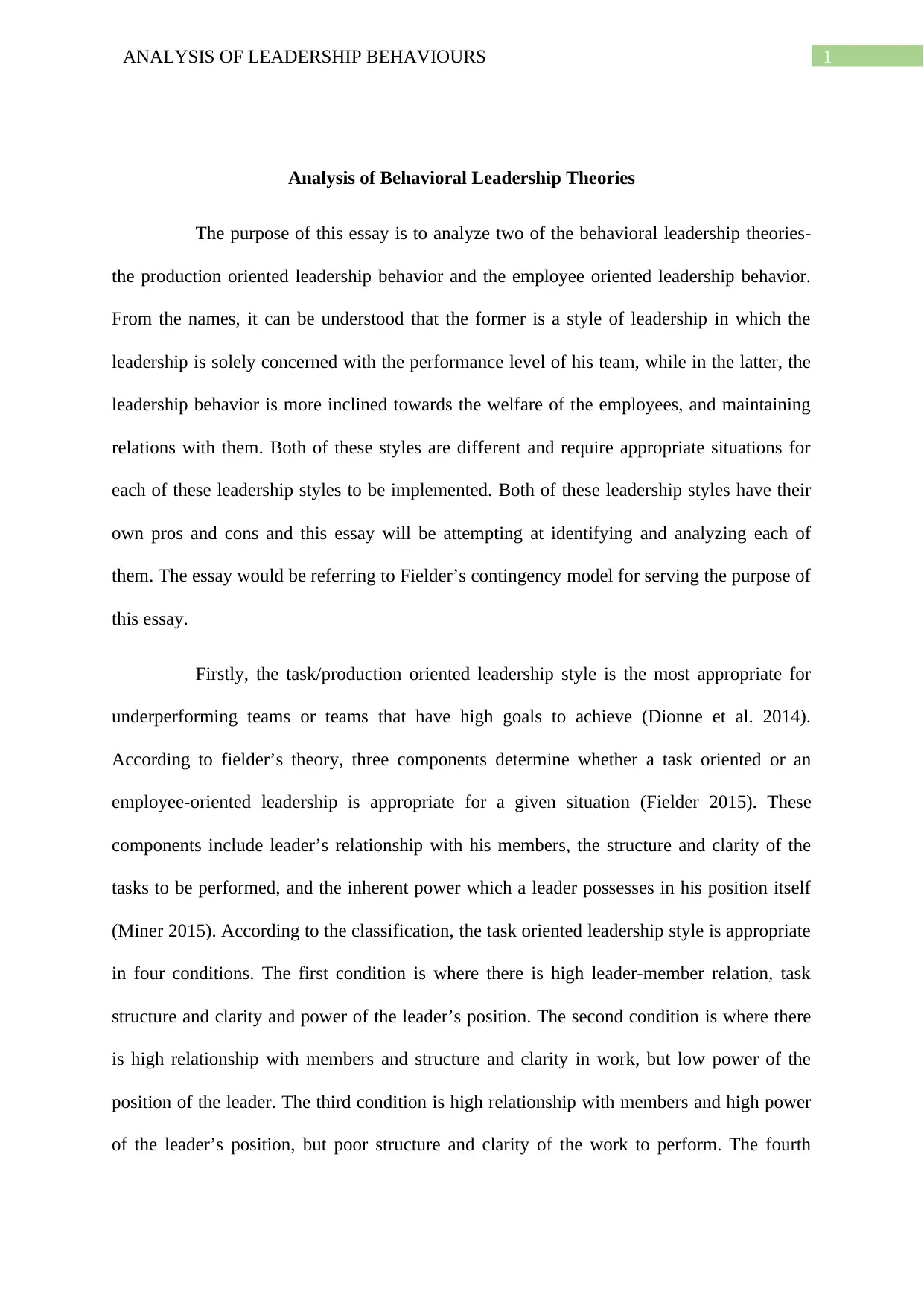
1ANALYSIS OF LEADERSHIP BEHAVIOURS
Analysis of Behavioral Leadership Theories
The purpose of this essay is to analyze two of the behavioral leadership theories-
the production oriented leadership behavior and the employee oriented leadership behavior.
From the names, it can be understood that the former is a style of leadership in which the
leadership is solely concerned with the performance level of his team, while in the latter, the
leadership behavior is more inclined towards the welfare of the employees, and maintaining
relations with them. Both of these styles are different and require appropriate situations for
each of these leadership styles to be implemented. Both of these leadership styles have their
own pros and cons and this essay will be attempting at identifying and analyzing each of
them. The essay would be referring to Fielder’s contingency model for serving the purpose of
this essay.
Firstly, the task/production oriented leadership style is the most appropriate for
underperforming teams or teams that have high goals to achieve (Dionne et al. 2014).
According to fielder’s theory, three components determine whether a task oriented or an
employee-oriented leadership is appropriate for a given situation (Fielder 2015). These
components include leader’s relationship with his members, the structure and clarity of the
tasks to be performed, and the inherent power which a leader possesses in his position itself
(Miner 2015). According to the classification, the task oriented leadership style is appropriate
in four conditions. The first condition is where there is high leader-member relation, task
structure and clarity and power of the leader’s position. The second condition is where there
is high relationship with members and structure and clarity in work, but low power of the
position of the leader. The third condition is high relationship with members and high power
of the leader’s position, but poor structure and clarity of the work to perform. The fourth
Analysis of Behavioral Leadership Theories
The purpose of this essay is to analyze two of the behavioral leadership theories-
the production oriented leadership behavior and the employee oriented leadership behavior.
From the names, it can be understood that the former is a style of leadership in which the
leadership is solely concerned with the performance level of his team, while in the latter, the
leadership behavior is more inclined towards the welfare of the employees, and maintaining
relations with them. Both of these styles are different and require appropriate situations for
each of these leadership styles to be implemented. Both of these leadership styles have their
own pros and cons and this essay will be attempting at identifying and analyzing each of
them. The essay would be referring to Fielder’s contingency model for serving the purpose of
this essay.
Firstly, the task/production oriented leadership style is the most appropriate for
underperforming teams or teams that have high goals to achieve (Dionne et al. 2014).
According to fielder’s theory, three components determine whether a task oriented or an
employee-oriented leadership is appropriate for a given situation (Fielder 2015). These
components include leader’s relationship with his members, the structure and clarity of the
tasks to be performed, and the inherent power which a leader possesses in his position itself
(Miner 2015). According to the classification, the task oriented leadership style is appropriate
in four conditions. The first condition is where there is high leader-member relation, task
structure and clarity and power of the leader’s position. The second condition is where there
is high relationship with members and structure and clarity in work, but low power of the
position of the leader. The third condition is high relationship with members and high power
of the leader’s position, but poor structure and clarity of the work to perform. The fourth
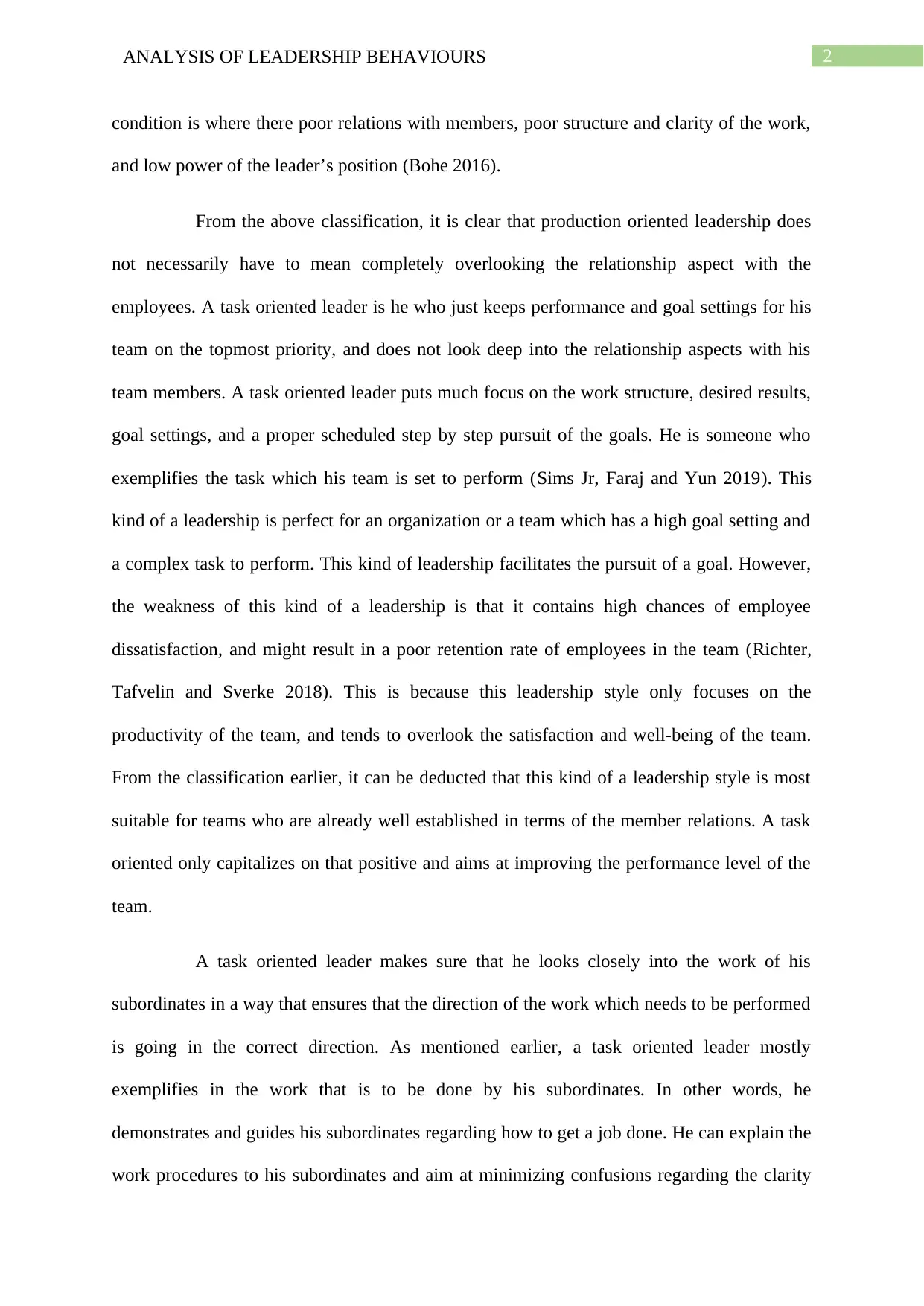
2ANALYSIS OF LEADERSHIP BEHAVIOURS
condition is where there poor relations with members, poor structure and clarity of the work,
and low power of the leader’s position (Bohe 2016).
From the above classification, it is clear that production oriented leadership does
not necessarily have to mean completely overlooking the relationship aspect with the
employees. A task oriented leader is he who just keeps performance and goal settings for his
team on the topmost priority, and does not look deep into the relationship aspects with his
team members. A task oriented leader puts much focus on the work structure, desired results,
goal settings, and a proper scheduled step by step pursuit of the goals. He is someone who
exemplifies the task which his team is set to perform (Sims Jr, Faraj and Yun 2019). This
kind of a leadership is perfect for an organization or a team which has a high goal setting and
a complex task to perform. This kind of leadership facilitates the pursuit of a goal. However,
the weakness of this kind of a leadership is that it contains high chances of employee
dissatisfaction, and might result in a poor retention rate of employees in the team (Richter,
Tafvelin and Sverke 2018). This is because this leadership style only focuses on the
productivity of the team, and tends to overlook the satisfaction and well-being of the team.
From the classification earlier, it can be deducted that this kind of a leadership style is most
suitable for teams who are already well established in terms of the member relations. A task
oriented only capitalizes on that positive and aims at improving the performance level of the
team.
A task oriented leader makes sure that he looks closely into the work of his
subordinates in a way that ensures that the direction of the work which needs to be performed
is going in the correct direction. As mentioned earlier, a task oriented leader mostly
exemplifies in the work that is to be done by his subordinates. In other words, he
demonstrates and guides his subordinates regarding how to get a job done. He can explain the
work procedures to his subordinates and aim at minimizing confusions regarding the clarity
condition is where there poor relations with members, poor structure and clarity of the work,
and low power of the leader’s position (Bohe 2016).
From the above classification, it is clear that production oriented leadership does
not necessarily have to mean completely overlooking the relationship aspect with the
employees. A task oriented leader is he who just keeps performance and goal settings for his
team on the topmost priority, and does not look deep into the relationship aspects with his
team members. A task oriented leader puts much focus on the work structure, desired results,
goal settings, and a proper scheduled step by step pursuit of the goals. He is someone who
exemplifies the task which his team is set to perform (Sims Jr, Faraj and Yun 2019). This
kind of a leadership is perfect for an organization or a team which has a high goal setting and
a complex task to perform. This kind of leadership facilitates the pursuit of a goal. However,
the weakness of this kind of a leadership is that it contains high chances of employee
dissatisfaction, and might result in a poor retention rate of employees in the team (Richter,
Tafvelin and Sverke 2018). This is because this leadership style only focuses on the
productivity of the team, and tends to overlook the satisfaction and well-being of the team.
From the classification earlier, it can be deducted that this kind of a leadership style is most
suitable for teams who are already well established in terms of the member relations. A task
oriented only capitalizes on that positive and aims at improving the performance level of the
team.
A task oriented leader makes sure that he looks closely into the work of his
subordinates in a way that ensures that the direction of the work which needs to be performed
is going in the correct direction. As mentioned earlier, a task oriented leader mostly
exemplifies in the work that is to be done by his subordinates. In other words, he
demonstrates and guides his subordinates regarding how to get a job done. He can explain the
work procedures to his subordinates and aim at minimizing confusions regarding the clarity
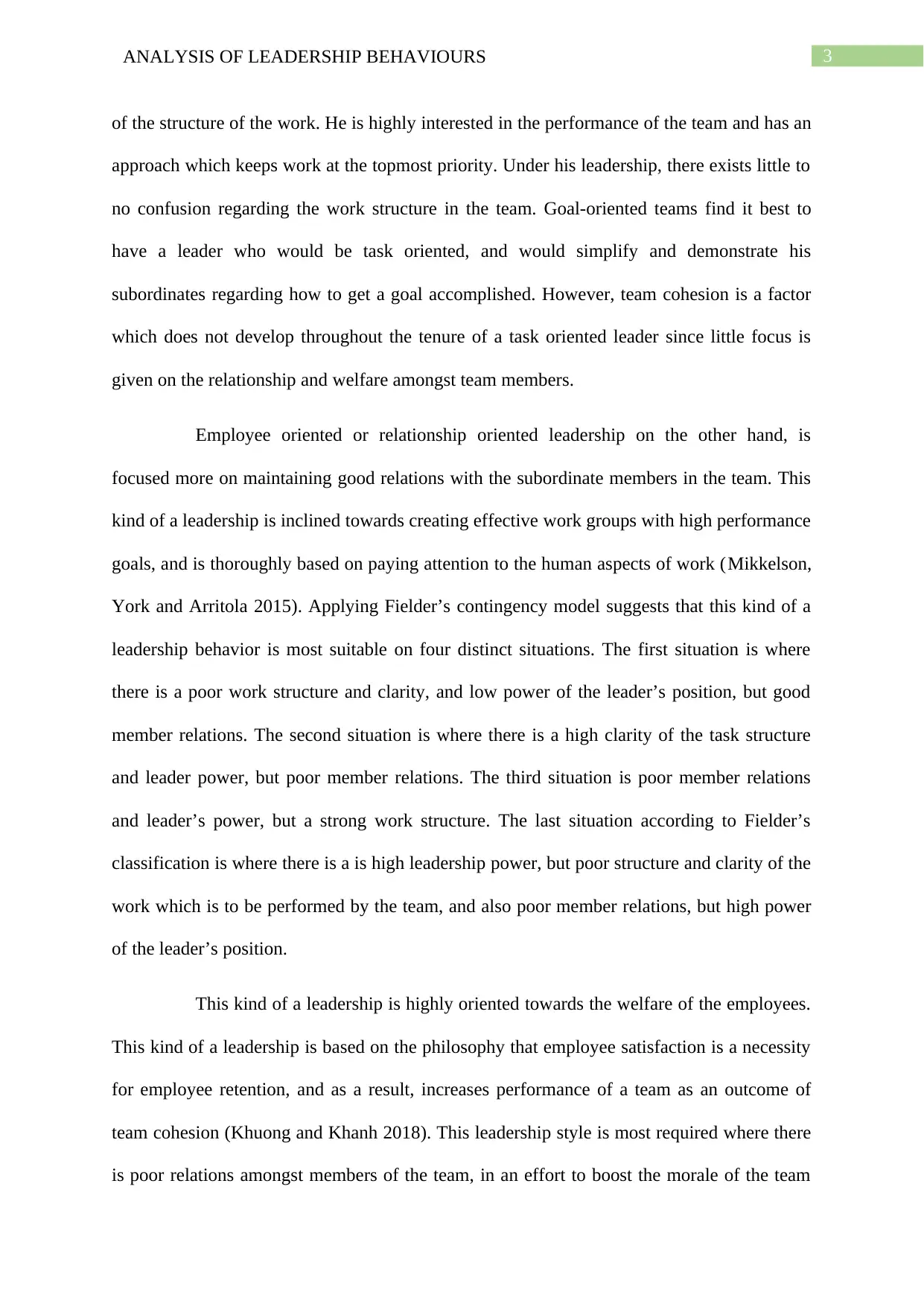
3ANALYSIS OF LEADERSHIP BEHAVIOURS
of the structure of the work. He is highly interested in the performance of the team and has an
approach which keeps work at the topmost priority. Under his leadership, there exists little to
no confusion regarding the work structure in the team. Goal-oriented teams find it best to
have a leader who would be task oriented, and would simplify and demonstrate his
subordinates regarding how to get a goal accomplished. However, team cohesion is a factor
which does not develop throughout the tenure of a task oriented leader since little focus is
given on the relationship and welfare amongst team members.
Employee oriented or relationship oriented leadership on the other hand, is
focused more on maintaining good relations with the subordinate members in the team. This
kind of a leadership is inclined towards creating effective work groups with high performance
goals, and is thoroughly based on paying attention to the human aspects of work (Mikkelson,
York and Arritola 2015). Applying Fielder’s contingency model suggests that this kind of a
leadership behavior is most suitable on four distinct situations. The first situation is where
there is a poor work structure and clarity, and low power of the leader’s position, but good
member relations. The second situation is where there is a high clarity of the task structure
and leader power, but poor member relations. The third situation is poor member relations
and leader’s power, but a strong work structure. The last situation according to Fielder’s
classification is where there is a is high leadership power, but poor structure and clarity of the
work which is to be performed by the team, and also poor member relations, but high power
of the leader’s position.
This kind of a leadership is highly oriented towards the welfare of the employees.
This kind of a leadership is based on the philosophy that employee satisfaction is a necessity
for employee retention, and as a result, increases performance of a team as an outcome of
team cohesion (Khuong and Khanh 2018). This leadership style is most required where there
is poor relations amongst members of the team, in an effort to boost the morale of the team
of the structure of the work. He is highly interested in the performance of the team and has an
approach which keeps work at the topmost priority. Under his leadership, there exists little to
no confusion regarding the work structure in the team. Goal-oriented teams find it best to
have a leader who would be task oriented, and would simplify and demonstrate his
subordinates regarding how to get a goal accomplished. However, team cohesion is a factor
which does not develop throughout the tenure of a task oriented leader since little focus is
given on the relationship and welfare amongst team members.
Employee oriented or relationship oriented leadership on the other hand, is
focused more on maintaining good relations with the subordinate members in the team. This
kind of a leadership is inclined towards creating effective work groups with high performance
goals, and is thoroughly based on paying attention to the human aspects of work (Mikkelson,
York and Arritola 2015). Applying Fielder’s contingency model suggests that this kind of a
leadership behavior is most suitable on four distinct situations. The first situation is where
there is a poor work structure and clarity, and low power of the leader’s position, but good
member relations. The second situation is where there is a high clarity of the task structure
and leader power, but poor member relations. The third situation is poor member relations
and leader’s power, but a strong work structure. The last situation according to Fielder’s
classification is where there is a is high leadership power, but poor structure and clarity of the
work which is to be performed by the team, and also poor member relations, but high power
of the leader’s position.
This kind of a leadership is highly oriented towards the welfare of the employees.
This kind of a leadership is based on the philosophy that employee satisfaction is a necessity
for employee retention, and as a result, increases performance of a team as an outcome of
team cohesion (Khuong and Khanh 2018). This leadership style is most required where there
is poor relations amongst members of the team, in an effort to boost the morale of the team
Secure Best Marks with AI Grader
Need help grading? Try our AI Grader for instant feedback on your assignments.
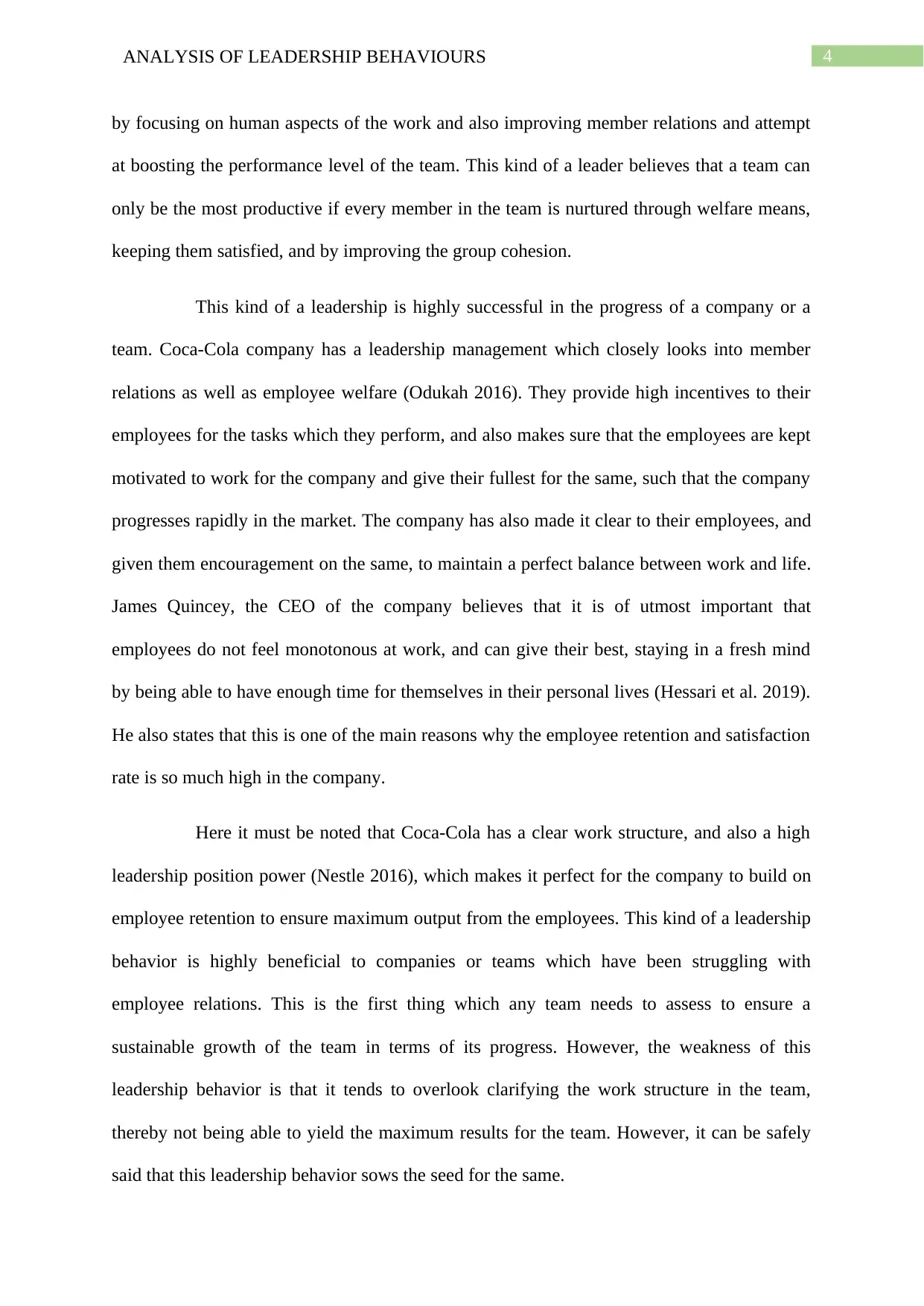
4ANALYSIS OF LEADERSHIP BEHAVIOURS
by focusing on human aspects of the work and also improving member relations and attempt
at boosting the performance level of the team. This kind of a leader believes that a team can
only be the most productive if every member in the team is nurtured through welfare means,
keeping them satisfied, and by improving the group cohesion.
This kind of a leadership is highly successful in the progress of a company or a
team. Coca-Cola company has a leadership management which closely looks into member
relations as well as employee welfare (Odukah 2016). They provide high incentives to their
employees for the tasks which they perform, and also makes sure that the employees are kept
motivated to work for the company and give their fullest for the same, such that the company
progresses rapidly in the market. The company has also made it clear to their employees, and
given them encouragement on the same, to maintain a perfect balance between work and life.
James Quincey, the CEO of the company believes that it is of utmost important that
employees do not feel monotonous at work, and can give their best, staying in a fresh mind
by being able to have enough time for themselves in their personal lives (Hessari et al. 2019).
He also states that this is one of the main reasons why the employee retention and satisfaction
rate is so much high in the company.
Here it must be noted that Coca-Cola has a clear work structure, and also a high
leadership position power (Nestle 2016), which makes it perfect for the company to build on
employee retention to ensure maximum output from the employees. This kind of a leadership
behavior is highly beneficial to companies or teams which have been struggling with
employee relations. This is the first thing which any team needs to assess to ensure a
sustainable growth of the team in terms of its progress. However, the weakness of this
leadership behavior is that it tends to overlook clarifying the work structure in the team,
thereby not being able to yield the maximum results for the team. However, it can be safely
said that this leadership behavior sows the seed for the same.
by focusing on human aspects of the work and also improving member relations and attempt
at boosting the performance level of the team. This kind of a leader believes that a team can
only be the most productive if every member in the team is nurtured through welfare means,
keeping them satisfied, and by improving the group cohesion.
This kind of a leadership is highly successful in the progress of a company or a
team. Coca-Cola company has a leadership management which closely looks into member
relations as well as employee welfare (Odukah 2016). They provide high incentives to their
employees for the tasks which they perform, and also makes sure that the employees are kept
motivated to work for the company and give their fullest for the same, such that the company
progresses rapidly in the market. The company has also made it clear to their employees, and
given them encouragement on the same, to maintain a perfect balance between work and life.
James Quincey, the CEO of the company believes that it is of utmost important that
employees do not feel monotonous at work, and can give their best, staying in a fresh mind
by being able to have enough time for themselves in their personal lives (Hessari et al. 2019).
He also states that this is one of the main reasons why the employee retention and satisfaction
rate is so much high in the company.
Here it must be noted that Coca-Cola has a clear work structure, and also a high
leadership position power (Nestle 2016), which makes it perfect for the company to build on
employee retention to ensure maximum output from the employees. This kind of a leadership
behavior is highly beneficial to companies or teams which have been struggling with
employee relations. This is the first thing which any team needs to assess to ensure a
sustainable growth of the team in terms of its progress. However, the weakness of this
leadership behavior is that it tends to overlook clarifying the work structure in the team,
thereby not being able to yield the maximum results for the team. However, it can be safely
said that this leadership behavior sows the seed for the same.
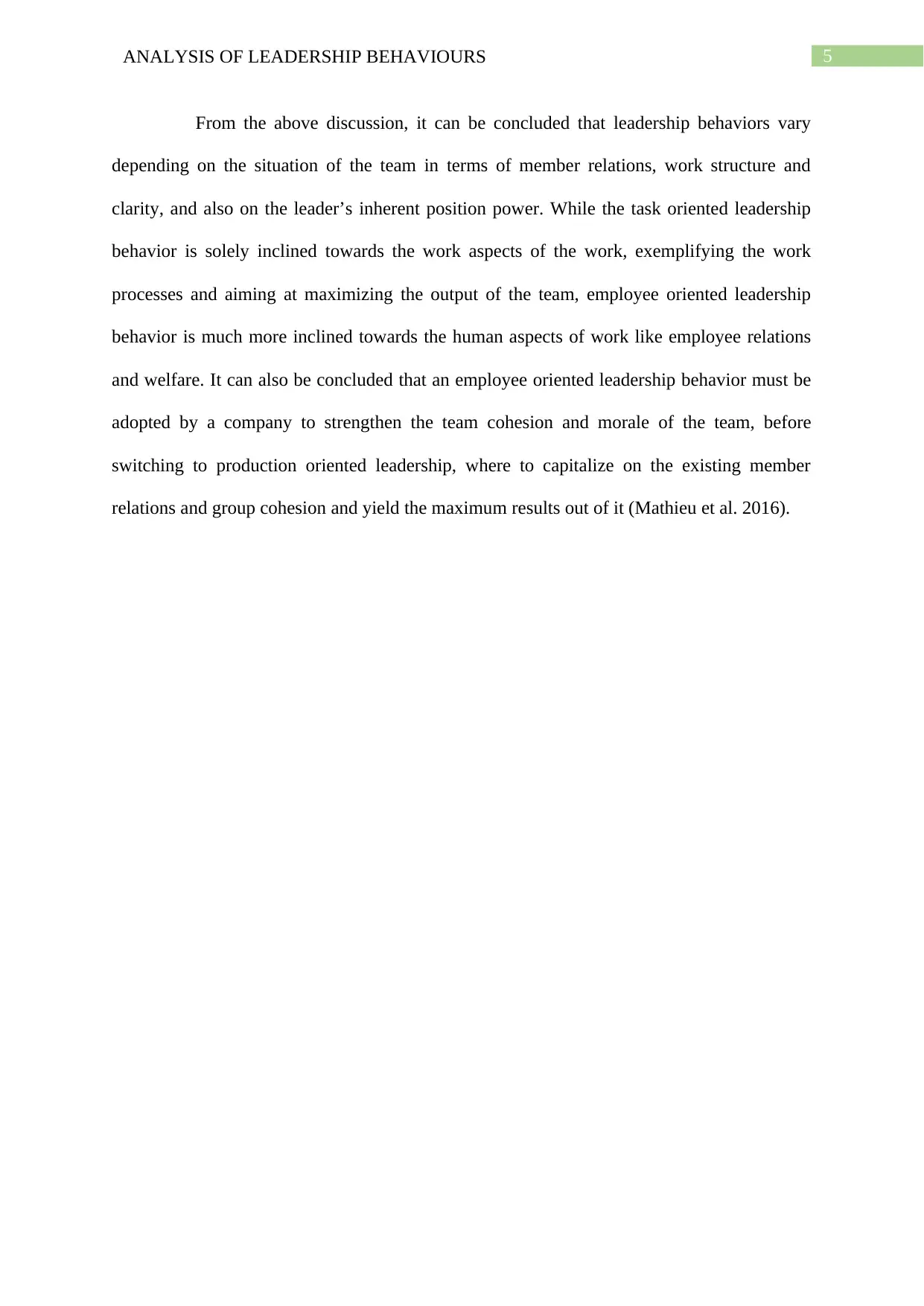
5ANALYSIS OF LEADERSHIP BEHAVIOURS
From the above discussion, it can be concluded that leadership behaviors vary
depending on the situation of the team in terms of member relations, work structure and
clarity, and also on the leader’s inherent position power. While the task oriented leadership
behavior is solely inclined towards the work aspects of the work, exemplifying the work
processes and aiming at maximizing the output of the team, employee oriented leadership
behavior is much more inclined towards the human aspects of work like employee relations
and welfare. It can also be concluded that an employee oriented leadership behavior must be
adopted by a company to strengthen the team cohesion and morale of the team, before
switching to production oriented leadership, where to capitalize on the existing member
relations and group cohesion and yield the maximum results out of it (Mathieu et al. 2016).
From the above discussion, it can be concluded that leadership behaviors vary
depending on the situation of the team in terms of member relations, work structure and
clarity, and also on the leader’s inherent position power. While the task oriented leadership
behavior is solely inclined towards the work aspects of the work, exemplifying the work
processes and aiming at maximizing the output of the team, employee oriented leadership
behavior is much more inclined towards the human aspects of work like employee relations
and welfare. It can also be concluded that an employee oriented leadership behavior must be
adopted by a company to strengthen the team cohesion and morale of the team, before
switching to production oriented leadership, where to capitalize on the existing member
relations and group cohesion and yield the maximum results out of it (Mathieu et al. 2016).
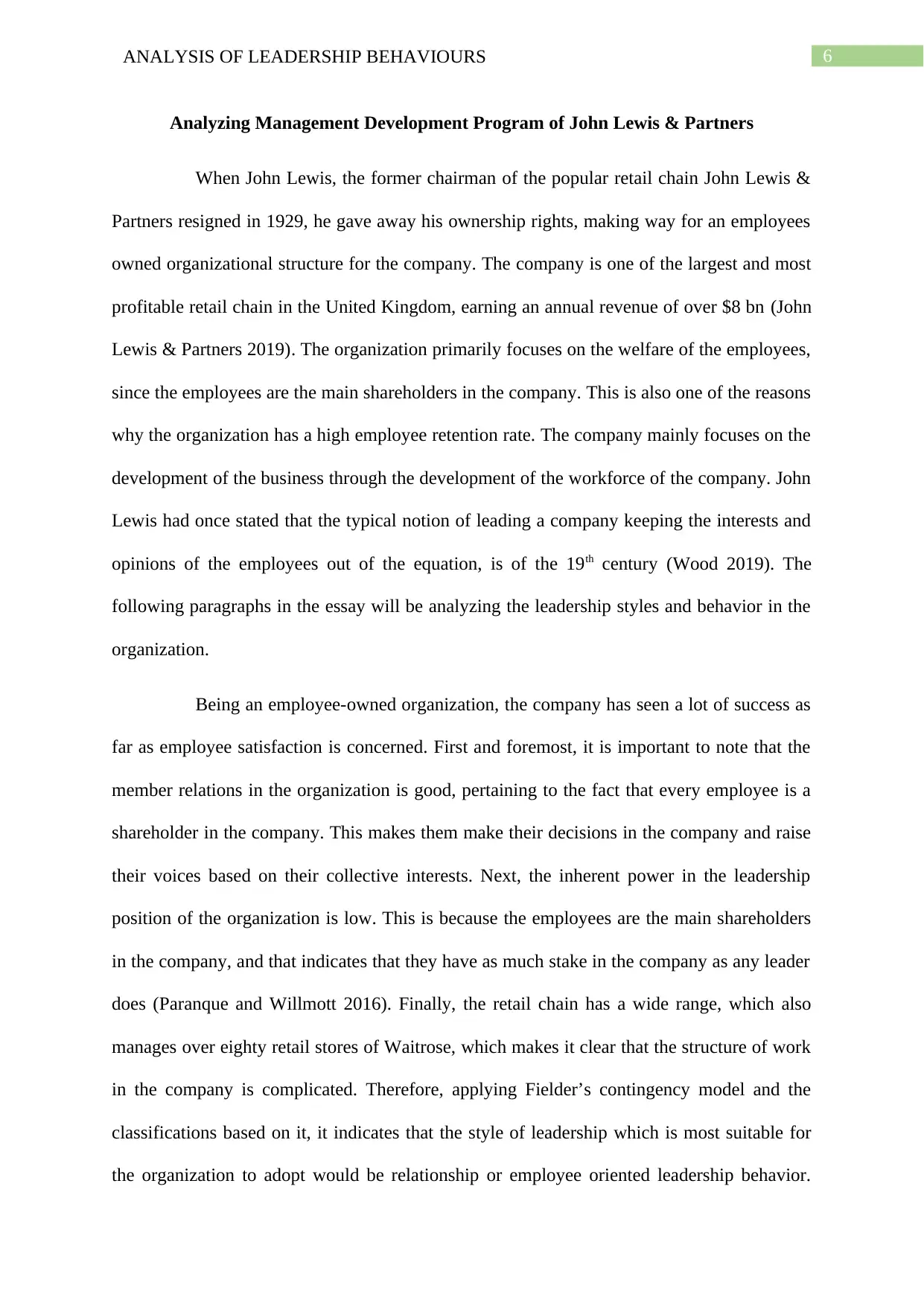
6ANALYSIS OF LEADERSHIP BEHAVIOURS
Analyzing Management Development Program of John Lewis & Partners
When John Lewis, the former chairman of the popular retail chain John Lewis &
Partners resigned in 1929, he gave away his ownership rights, making way for an employees
owned organizational structure for the company. The company is one of the largest and most
profitable retail chain in the United Kingdom, earning an annual revenue of over $8 bn (John
Lewis & Partners 2019). The organization primarily focuses on the welfare of the employees,
since the employees are the main shareholders in the company. This is also one of the reasons
why the organization has a high employee retention rate. The company mainly focuses on the
development of the business through the development of the workforce of the company. John
Lewis had once stated that the typical notion of leading a company keeping the interests and
opinions of the employees out of the equation, is of the 19th century (Wood 2019). The
following paragraphs in the essay will be analyzing the leadership styles and behavior in the
organization.
Being an employee-owned organization, the company has seen a lot of success as
far as employee satisfaction is concerned. First and foremost, it is important to note that the
member relations in the organization is good, pertaining to the fact that every employee is a
shareholder in the company. This makes them make their decisions in the company and raise
their voices based on their collective interests. Next, the inherent power in the leadership
position of the organization is low. This is because the employees are the main shareholders
in the company, and that indicates that they have as much stake in the company as any leader
does (Paranque and Willmott 2016). Finally, the retail chain has a wide range, which also
manages over eighty retail stores of Waitrose, which makes it clear that the structure of work
in the company is complicated. Therefore, applying Fielder’s contingency model and the
classifications based on it, it indicates that the style of leadership which is most suitable for
the organization to adopt would be relationship or employee oriented leadership behavior.
Analyzing Management Development Program of John Lewis & Partners
When John Lewis, the former chairman of the popular retail chain John Lewis &
Partners resigned in 1929, he gave away his ownership rights, making way for an employees
owned organizational structure for the company. The company is one of the largest and most
profitable retail chain in the United Kingdom, earning an annual revenue of over $8 bn (John
Lewis & Partners 2019). The organization primarily focuses on the welfare of the employees,
since the employees are the main shareholders in the company. This is also one of the reasons
why the organization has a high employee retention rate. The company mainly focuses on the
development of the business through the development of the workforce of the company. John
Lewis had once stated that the typical notion of leading a company keeping the interests and
opinions of the employees out of the equation, is of the 19th century (Wood 2019). The
following paragraphs in the essay will be analyzing the leadership styles and behavior in the
organization.
Being an employee-owned organization, the company has seen a lot of success as
far as employee satisfaction is concerned. First and foremost, it is important to note that the
member relations in the organization is good, pertaining to the fact that every employee is a
shareholder in the company. This makes them make their decisions in the company and raise
their voices based on their collective interests. Next, the inherent power in the leadership
position of the organization is low. This is because the employees are the main shareholders
in the company, and that indicates that they have as much stake in the company as any leader
does (Paranque and Willmott 2016). Finally, the retail chain has a wide range, which also
manages over eighty retail stores of Waitrose, which makes it clear that the structure of work
in the company is complicated. Therefore, applying Fielder’s contingency model and the
classifications based on it, it indicates that the style of leadership which is most suitable for
the organization to adopt would be relationship or employee oriented leadership behavior.
Paraphrase This Document
Need a fresh take? Get an instant paraphrase of this document with our AI Paraphraser

7ANALYSIS OF LEADERSHIP BEHAVIOURS
This is the reason why this kind of a leadership has succeeded in the organization. The main
objective of this leadership is to make progress in the market, keeping the collective interests
of the staffs in mind.
The leadership and management style of this company is purely democratic. The
organization has a staff council, which looks after the complaints, requirements and
feedbacks of the staffs of the organization. Every staff from the top to the bottom is allowed
to voice their opinions in written documents to this council, or may opt to anonymously bring
the issue forward to the eyes of the management in the annual magazine of the organization.
This highly enables the employees of the organization to have their interests answered and
also seek the proper benefits which they require. This lets the employees of the organization
be the sole drivers of the organizations themselves, making decisions autonomously without
the influence and reliance on a higher authority (Storey and Salaman 2017).
To be precise, the organization has a simple and common leadership or
organizational structure. There is a higher management that looks after the business
operations and development of the organization, under which various departments operate in
various aspects of the organization. It is only the leadership behavior and characteristics
which make the difference (Catchcart 2013). Specifically, the management program which is
referred to in this essay is that of an employee-owned business operations program, which
has been existing in the organization for quite some time now (Catchcart 2019).
One important thing to note about the results of this management program is that
it has led to the organization being one of the fastest growing retail chain in the United
Kingdom, alongside the fact that it has also facilitated the company maintain its market share
and even expand it. Thus, the company has not incurred losses from this program, especially
pertaining to the fact that it has stuck to this program for decades now. Therefore, it can be
This is the reason why this kind of a leadership has succeeded in the organization. The main
objective of this leadership is to make progress in the market, keeping the collective interests
of the staffs in mind.
The leadership and management style of this company is purely democratic. The
organization has a staff council, which looks after the complaints, requirements and
feedbacks of the staffs of the organization. Every staff from the top to the bottom is allowed
to voice their opinions in written documents to this council, or may opt to anonymously bring
the issue forward to the eyes of the management in the annual magazine of the organization.
This highly enables the employees of the organization to have their interests answered and
also seek the proper benefits which they require. This lets the employees of the organization
be the sole drivers of the organizations themselves, making decisions autonomously without
the influence and reliance on a higher authority (Storey and Salaman 2017).
To be precise, the organization has a simple and common leadership or
organizational structure. There is a higher management that looks after the business
operations and development of the organization, under which various departments operate in
various aspects of the organization. It is only the leadership behavior and characteristics
which make the difference (Catchcart 2013). Specifically, the management program which is
referred to in this essay is that of an employee-owned business operations program, which
has been existing in the organization for quite some time now (Catchcart 2019).
One important thing to note about the results of this management program is that
it has led to the organization being one of the fastest growing retail chain in the United
Kingdom, alongside the fact that it has also facilitated the company maintain its market share
and even expand it. Thus, the company has not incurred losses from this program, especially
pertaining to the fact that it has stuck to this program for decades now. Therefore, it can be

8ANALYSIS OF LEADERSHIP BEHAVIOURS
said that the management program has suited the needs of the organization according to its
situation and conditions.
Coming to the core analysis part, the system of considering employee
requirements by having a separate staffs council empowers the workers of the organization. It
is a collective movement of the workers of the organization to give direction to the business
of the organization. This kind of leadership makes use of the high market share and revenue
which the organization is already gaining from its ventures, and thus, now it is emphasizing
on building and strengthening the workforce relations. This is actually the opposite to what
an ideal sequence would be, but has nonetheless benefited the organization immensely over
the last few decades. Although the type of leadership that exists in the organization is typical
of a employee oriented style of leadership, it is not entirely the case. As discussed earlier, the
company has a simple and common organizational structure. That is to say, under the
management department of the organization, several departments of the organization operate,
each of which have a specific leader to lead the department in terms of the tasks that are
needed to perform. These tasks are clearly structured, when looked at from the micro
perspective. This is because no matter how big the organization is and how complicated its
business can get, every team has their tasks well outlined to it, so that it can guide itself to
achieve its goals. The organization is known to have a structure that is led by brilliant minds
in the retail sales industry, who lead and guide the team towards the goal that each team
pursues.
The requirements and development of the business and its agenda are set by the
organization, taking into consideration the collective interests of the employees of the
organization. From there, the goals and agendas of the organization are set for the
organization, which it needs to pursue. This is further accomplished by the leaders in each
department, with their expertise and guidance to their subordinates. This is perfectly typical
said that the management program has suited the needs of the organization according to its
situation and conditions.
Coming to the core analysis part, the system of considering employee
requirements by having a separate staffs council empowers the workers of the organization. It
is a collective movement of the workers of the organization to give direction to the business
of the organization. This kind of leadership makes use of the high market share and revenue
which the organization is already gaining from its ventures, and thus, now it is emphasizing
on building and strengthening the workforce relations. This is actually the opposite to what
an ideal sequence would be, but has nonetheless benefited the organization immensely over
the last few decades. Although the type of leadership that exists in the organization is typical
of a employee oriented style of leadership, it is not entirely the case. As discussed earlier, the
company has a simple and common organizational structure. That is to say, under the
management department of the organization, several departments of the organization operate,
each of which have a specific leader to lead the department in terms of the tasks that are
needed to perform. These tasks are clearly structured, when looked at from the micro
perspective. This is because no matter how big the organization is and how complicated its
business can get, every team has their tasks well outlined to it, so that it can guide itself to
achieve its goals. The organization is known to have a structure that is led by brilliant minds
in the retail sales industry, who lead and guide the team towards the goal that each team
pursues.
The requirements and development of the business and its agenda are set by the
organization, taking into consideration the collective interests of the employees of the
organization. From there, the goals and agendas of the organization are set for the
organization, which it needs to pursue. This is further accomplished by the leaders in each
department, with their expertise and guidance to their subordinates. This is perfectly typical
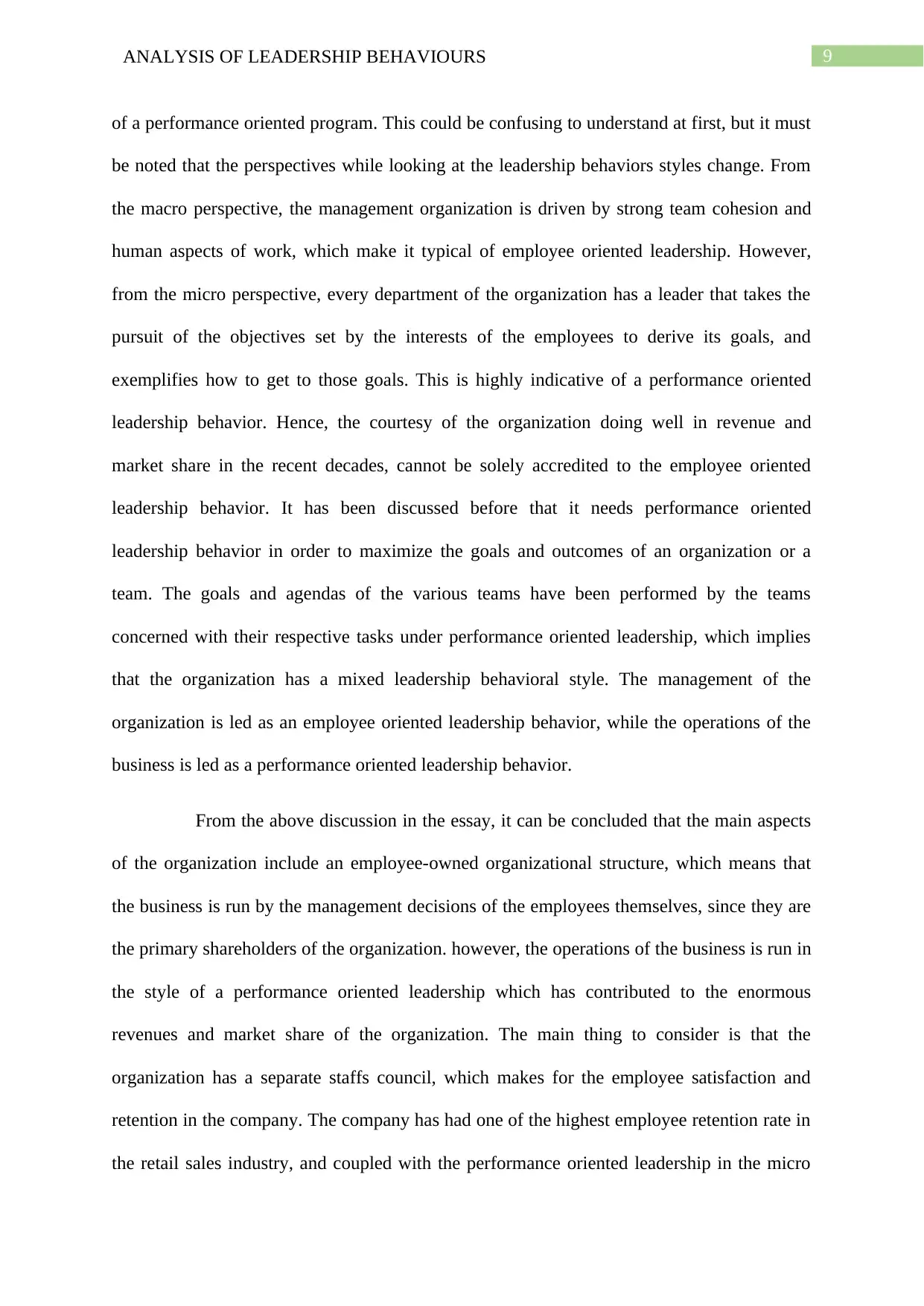
9ANALYSIS OF LEADERSHIP BEHAVIOURS
of a performance oriented program. This could be confusing to understand at first, but it must
be noted that the perspectives while looking at the leadership behaviors styles change. From
the macro perspective, the management organization is driven by strong team cohesion and
human aspects of work, which make it typical of employee oriented leadership. However,
from the micro perspective, every department of the organization has a leader that takes the
pursuit of the objectives set by the interests of the employees to derive its goals, and
exemplifies how to get to those goals. This is highly indicative of a performance oriented
leadership behavior. Hence, the courtesy of the organization doing well in revenue and
market share in the recent decades, cannot be solely accredited to the employee oriented
leadership behavior. It has been discussed before that it needs performance oriented
leadership behavior in order to maximize the goals and outcomes of an organization or a
team. The goals and agendas of the various teams have been performed by the teams
concerned with their respective tasks under performance oriented leadership, which implies
that the organization has a mixed leadership behavioral style. The management of the
organization is led as an employee oriented leadership behavior, while the operations of the
business is led as a performance oriented leadership behavior.
From the above discussion in the essay, it can be concluded that the main aspects
of the organization include an employee-owned organizational structure, which means that
the business is run by the management decisions of the employees themselves, since they are
the primary shareholders of the organization. however, the operations of the business is run in
the style of a performance oriented leadership which has contributed to the enormous
revenues and market share of the organization. The main thing to consider is that the
organization has a separate staffs council, which makes for the employee satisfaction and
retention in the company. The company has had one of the highest employee retention rate in
the retail sales industry, and coupled with the performance oriented leadership in the micro
of a performance oriented program. This could be confusing to understand at first, but it must
be noted that the perspectives while looking at the leadership behaviors styles change. From
the macro perspective, the management organization is driven by strong team cohesion and
human aspects of work, which make it typical of employee oriented leadership. However,
from the micro perspective, every department of the organization has a leader that takes the
pursuit of the objectives set by the interests of the employees to derive its goals, and
exemplifies how to get to those goals. This is highly indicative of a performance oriented
leadership behavior. Hence, the courtesy of the organization doing well in revenue and
market share in the recent decades, cannot be solely accredited to the employee oriented
leadership behavior. It has been discussed before that it needs performance oriented
leadership behavior in order to maximize the goals and outcomes of an organization or a
team. The goals and agendas of the various teams have been performed by the teams
concerned with their respective tasks under performance oriented leadership, which implies
that the organization has a mixed leadership behavioral style. The management of the
organization is led as an employee oriented leadership behavior, while the operations of the
business is led as a performance oriented leadership behavior.
From the above discussion in the essay, it can be concluded that the main aspects
of the organization include an employee-owned organizational structure, which means that
the business is run by the management decisions of the employees themselves, since they are
the primary shareholders of the organization. however, the operations of the business is run in
the style of a performance oriented leadership which has contributed to the enormous
revenues and market share of the organization. The main thing to consider is that the
organization has a separate staffs council, which makes for the employee satisfaction and
retention in the company. The company has had one of the highest employee retention rate in
the retail sales industry, and coupled with the performance oriented leadership in the micro
Secure Best Marks with AI Grader
Need help grading? Try our AI Grader for instant feedback on your assignments.
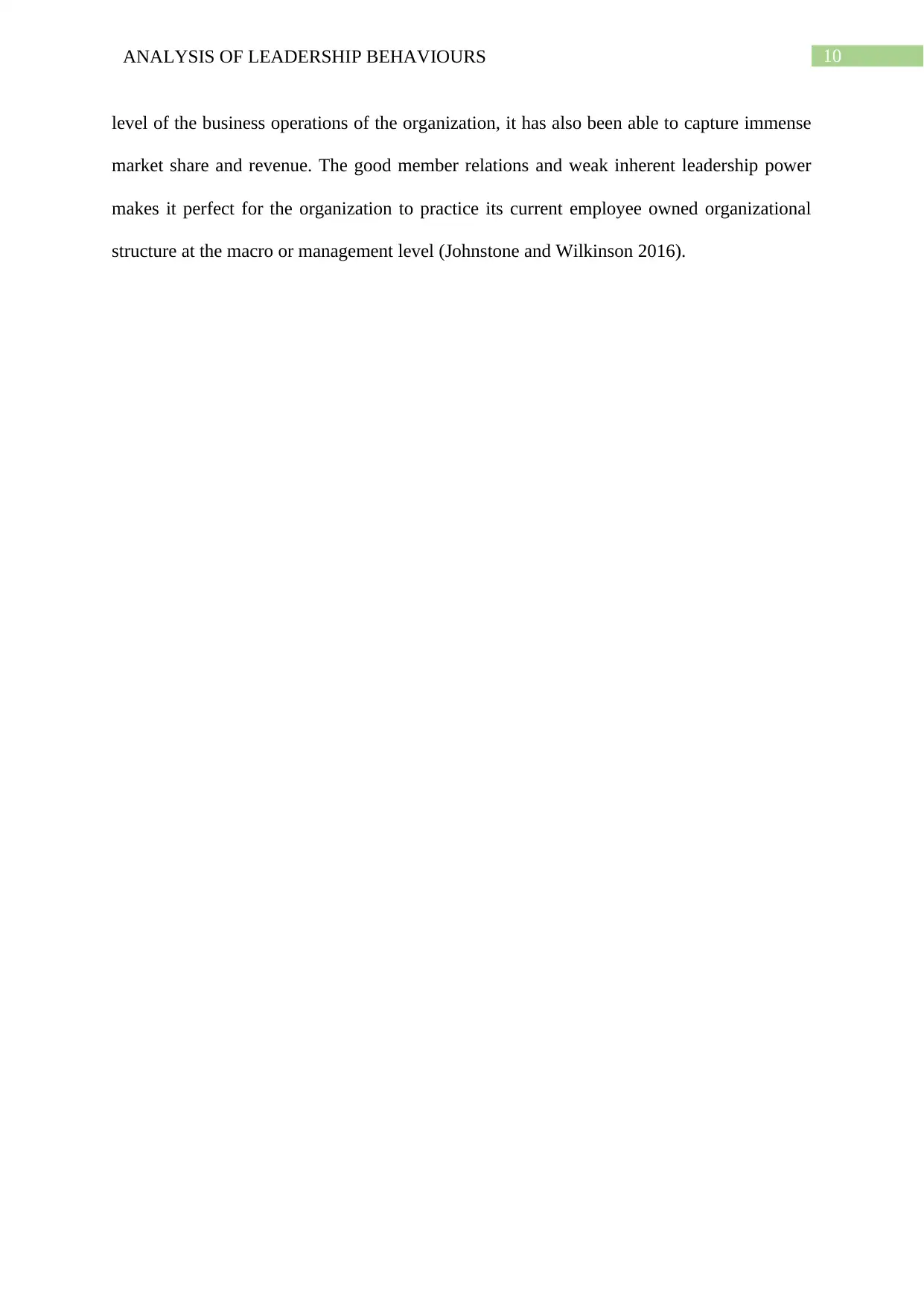
10ANALYSIS OF LEADERSHIP BEHAVIOURS
level of the business operations of the organization, it has also been able to capture immense
market share and revenue. The good member relations and weak inherent leadership power
makes it perfect for the organization to practice its current employee owned organizational
structure at the macro or management level (Johnstone and Wilkinson 2016).
level of the business operations of the organization, it has also been able to capture immense
market share and revenue. The good member relations and weak inherent leadership power
makes it perfect for the organization to practice its current employee owned organizational
structure at the macro or management level (Johnstone and Wilkinson 2016).
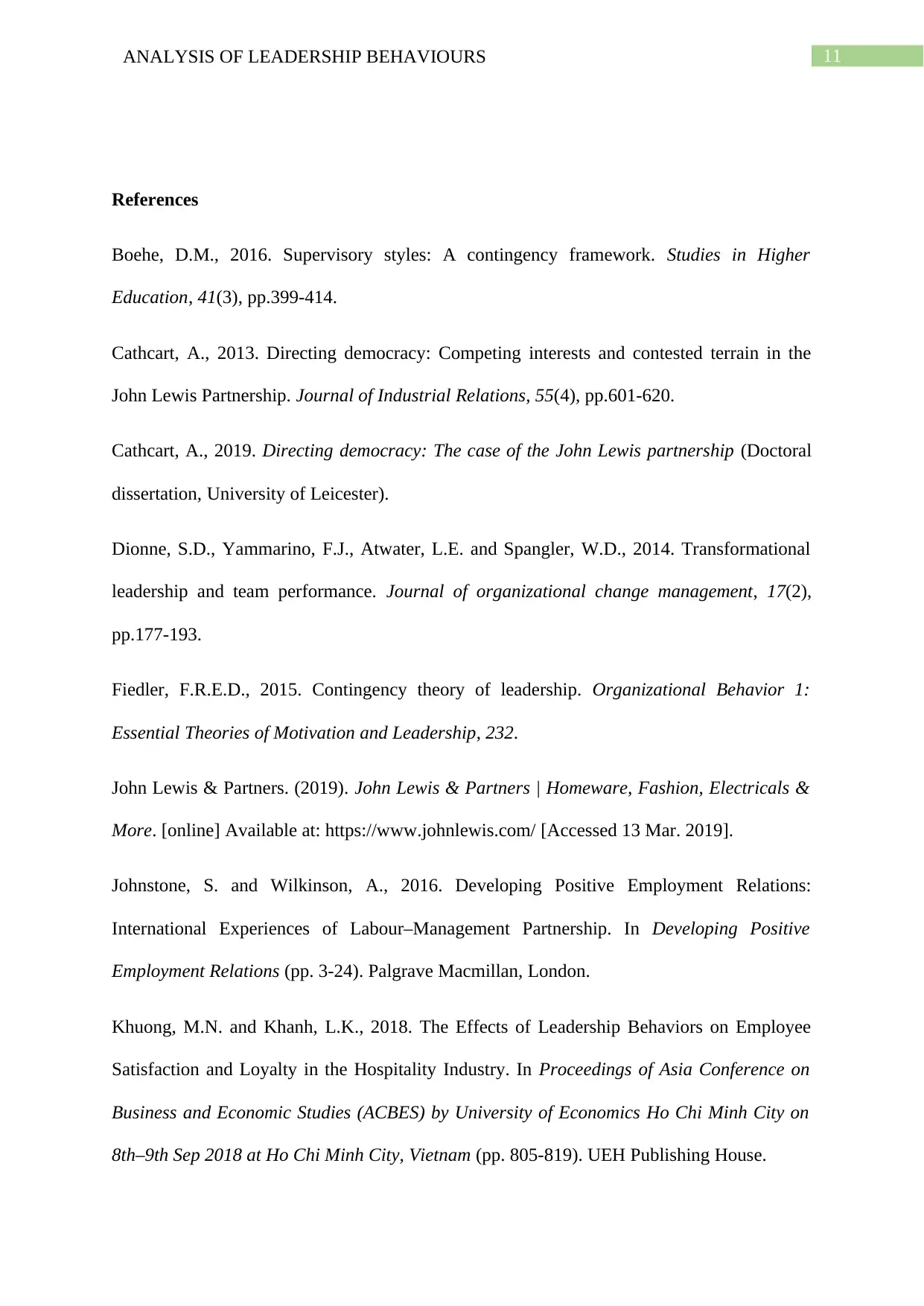
11ANALYSIS OF LEADERSHIP BEHAVIOURS
References
Boehe, D.M., 2016. Supervisory styles: A contingency framework. Studies in Higher
Education, 41(3), pp.399-414.
Cathcart, A., 2013. Directing democracy: Competing interests and contested terrain in the
John Lewis Partnership. Journal of Industrial Relations, 55(4), pp.601-620.
Cathcart, A., 2019. Directing democracy: The case of the John Lewis partnership (Doctoral
dissertation, University of Leicester).
Dionne, S.D., Yammarino, F.J., Atwater, L.E. and Spangler, W.D., 2014. Transformational
leadership and team performance. Journal of organizational change management, 17(2),
pp.177-193.
Fiedler, F.R.E.D., 2015. Contingency theory of leadership. Organizational Behavior 1:
Essential Theories of Motivation and Leadership, 232.
John Lewis & Partners. (2019). John Lewis & Partners | Homeware, Fashion, Electricals &
More. [online] Available at: https://www.johnlewis.com/ [Accessed 13 Mar. 2019].
Johnstone, S. and Wilkinson, A., 2016. Developing Positive Employment Relations:
International Experiences of Labour–Management Partnership. In Developing Positive
Employment Relations (pp. 3-24). Palgrave Macmillan, London.
Khuong, M.N. and Khanh, L.K., 2018. The Effects of Leadership Behaviors on Employee
Satisfaction and Loyalty in the Hospitality Industry. In Proceedings of Asia Conference on
Business and Economic Studies (ACBES) by University of Economics Ho Chi Minh City on
8th–9th Sep 2018 at Ho Chi Minh City, Vietnam (pp. 805-819). UEH Publishing House.
References
Boehe, D.M., 2016. Supervisory styles: A contingency framework. Studies in Higher
Education, 41(3), pp.399-414.
Cathcart, A., 2013. Directing democracy: Competing interests and contested terrain in the
John Lewis Partnership. Journal of Industrial Relations, 55(4), pp.601-620.
Cathcart, A., 2019. Directing democracy: The case of the John Lewis partnership (Doctoral
dissertation, University of Leicester).
Dionne, S.D., Yammarino, F.J., Atwater, L.E. and Spangler, W.D., 2014. Transformational
leadership and team performance. Journal of organizational change management, 17(2),
pp.177-193.
Fiedler, F.R.E.D., 2015. Contingency theory of leadership. Organizational Behavior 1:
Essential Theories of Motivation and Leadership, 232.
John Lewis & Partners. (2019). John Lewis & Partners | Homeware, Fashion, Electricals &
More. [online] Available at: https://www.johnlewis.com/ [Accessed 13 Mar. 2019].
Johnstone, S. and Wilkinson, A., 2016. Developing Positive Employment Relations:
International Experiences of Labour–Management Partnership. In Developing Positive
Employment Relations (pp. 3-24). Palgrave Macmillan, London.
Khuong, M.N. and Khanh, L.K., 2018. The Effects of Leadership Behaviors on Employee
Satisfaction and Loyalty in the Hospitality Industry. In Proceedings of Asia Conference on
Business and Economic Studies (ACBES) by University of Economics Ho Chi Minh City on
8th–9th Sep 2018 at Ho Chi Minh City, Vietnam (pp. 805-819). UEH Publishing House.

12ANALYSIS OF LEADERSHIP BEHAVIOURS
MAANI HESSARI, N.A.S.O.N., RUSKIN, G., McKEE, M.A.R.T.I.N. and STUCKLER, D.,
2019. Public Meets Private: Conversations Between Coca‐Cola and the CDC. The Milbank
Quarterly.
Mathieu, C., Fabi, B., Lacoursière, R. and Raymond, L., 2016. The role of supervisory
behavior, job satisfaction and organizational commitment on employee turnover. Journal of
Management & Organization, 22(1), pp.113-129.
Mikkelson, A.C., York, J.A. and Arritola, J., 2015. Communication competence, leadership
behaviors, and employee outcomes in supervisor-employee relationships. Business and
Professional Communication Quarterly, 78(3), pp.336-354.
Miner, J.B., 2015. From Fred Fiedler’s Contingency Theory of Leadership to the Leader-
Match Approach to Management Development. In Organizational Behavior 4 (pp. 164-174).
Routledge.
Nestle, M., 2016. Search results: Coca Cola. Am J Clin Nutr, 103, pp.258-267.
Odukah, M.E., 2016. Factors Influencing Staff Motivation among Employees: A Case Study
of Equator Bottlers (Coca Cola) Kenya. Journal of Human Resource and Sustainability
Studies, 4(02), p.68.
Paranque, B. and Willmott, H., 2016. Cooperatives–An Alternative to Capitalism? The Case
of the John Lewis Partnership☆. In Finance Reconsidered: New Perspectives for a
Responsible and Sustainable Finance (pp. 263-296). Emerald Group Publishing Limited.
Richter, A., Tafvelin, S. and Sverke, M., 2018. The mediated relationship of leadership on
job insecurity. Scandinavian Journal of Work and Organizational Psychology, 3(1).
Salaman, G. and Storey, J., 2016. A Better Way of Doing Business?: Lessons from the John
Lewis Partnership. Oxford University Press.
MAANI HESSARI, N.A.S.O.N., RUSKIN, G., McKEE, M.A.R.T.I.N. and STUCKLER, D.,
2019. Public Meets Private: Conversations Between Coca‐Cola and the CDC. The Milbank
Quarterly.
Mathieu, C., Fabi, B., Lacoursière, R. and Raymond, L., 2016. The role of supervisory
behavior, job satisfaction and organizational commitment on employee turnover. Journal of
Management & Organization, 22(1), pp.113-129.
Mikkelson, A.C., York, J.A. and Arritola, J., 2015. Communication competence, leadership
behaviors, and employee outcomes in supervisor-employee relationships. Business and
Professional Communication Quarterly, 78(3), pp.336-354.
Miner, J.B., 2015. From Fred Fiedler’s Contingency Theory of Leadership to the Leader-
Match Approach to Management Development. In Organizational Behavior 4 (pp. 164-174).
Routledge.
Nestle, M., 2016. Search results: Coca Cola. Am J Clin Nutr, 103, pp.258-267.
Odukah, M.E., 2016. Factors Influencing Staff Motivation among Employees: A Case Study
of Equator Bottlers (Coca Cola) Kenya. Journal of Human Resource and Sustainability
Studies, 4(02), p.68.
Paranque, B. and Willmott, H., 2016. Cooperatives–An Alternative to Capitalism? The Case
of the John Lewis Partnership☆. In Finance Reconsidered: New Perspectives for a
Responsible and Sustainable Finance (pp. 263-296). Emerald Group Publishing Limited.
Richter, A., Tafvelin, S. and Sverke, M., 2018. The mediated relationship of leadership on
job insecurity. Scandinavian Journal of Work and Organizational Psychology, 3(1).
Salaman, G. and Storey, J., 2016. A Better Way of Doing Business?: Lessons from the John
Lewis Partnership. Oxford University Press.
Paraphrase This Document
Need a fresh take? Get an instant paraphrase of this document with our AI Paraphraser
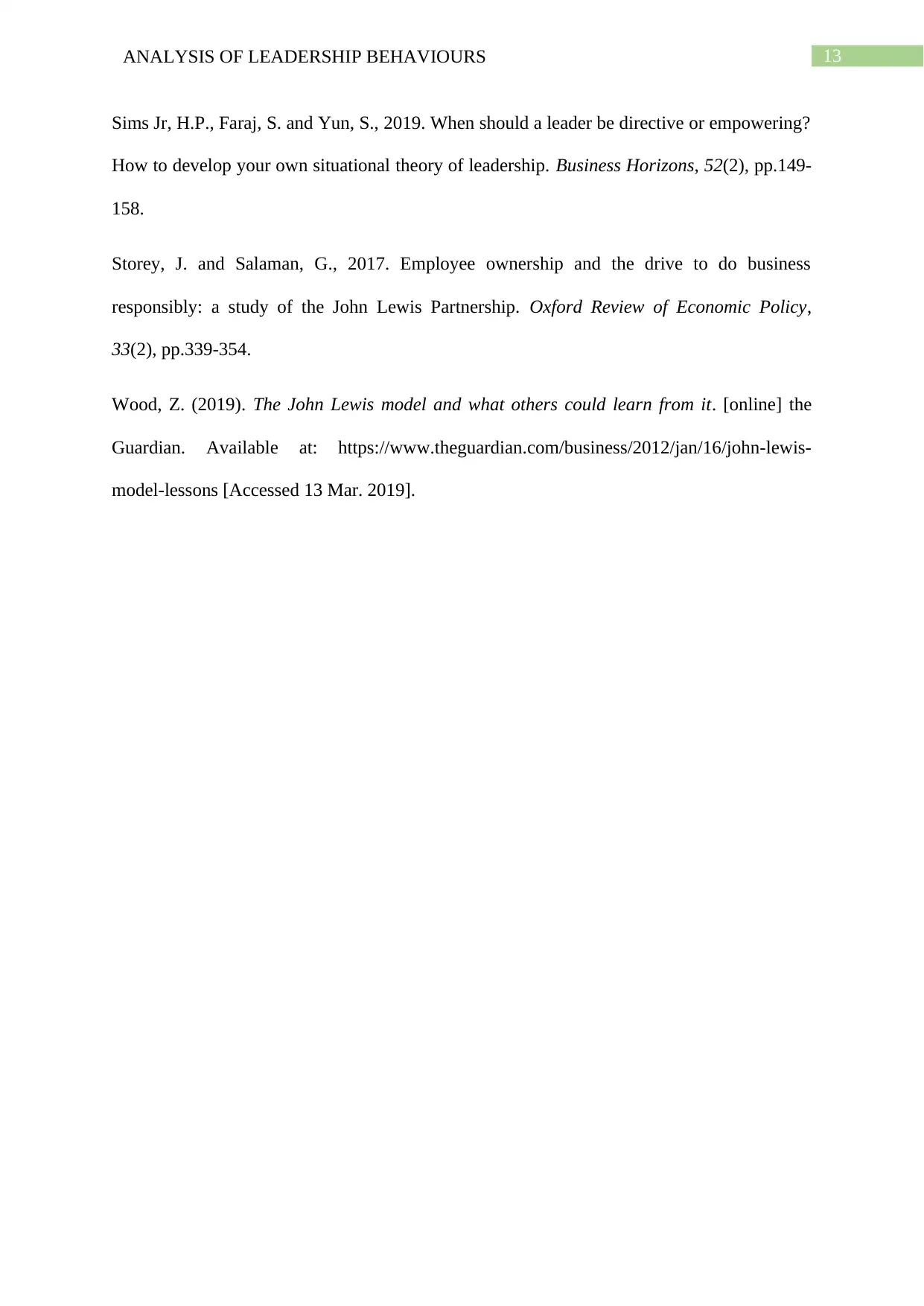
13ANALYSIS OF LEADERSHIP BEHAVIOURS
Sims Jr, H.P., Faraj, S. and Yun, S., 2019. When should a leader be directive or empowering?
How to develop your own situational theory of leadership. Business Horizons, 52(2), pp.149-
158.
Storey, J. and Salaman, G., 2017. Employee ownership and the drive to do business
responsibly: a study of the John Lewis Partnership. Oxford Review of Economic Policy,
33(2), pp.339-354.
Wood, Z. (2019). The John Lewis model and what others could learn from it. [online] the
Guardian. Available at: https://www.theguardian.com/business/2012/jan/16/john-lewis-
model-lessons [Accessed 13 Mar. 2019].
Sims Jr, H.P., Faraj, S. and Yun, S., 2019. When should a leader be directive or empowering?
How to develop your own situational theory of leadership. Business Horizons, 52(2), pp.149-
158.
Storey, J. and Salaman, G., 2017. Employee ownership and the drive to do business
responsibly: a study of the John Lewis Partnership. Oxford Review of Economic Policy,
33(2), pp.339-354.
Wood, Z. (2019). The John Lewis model and what others could learn from it. [online] the
Guardian. Available at: https://www.theguardian.com/business/2012/jan/16/john-lewis-
model-lessons [Accessed 13 Mar. 2019].
1 out of 14
Related Documents
Your All-in-One AI-Powered Toolkit for Academic Success.
+13062052269
info@desklib.com
Available 24*7 on WhatsApp / Email
![[object Object]](/_next/static/media/star-bottom.7253800d.svg)
Unlock your academic potential
© 2024 | Zucol Services PVT LTD | All rights reserved.





